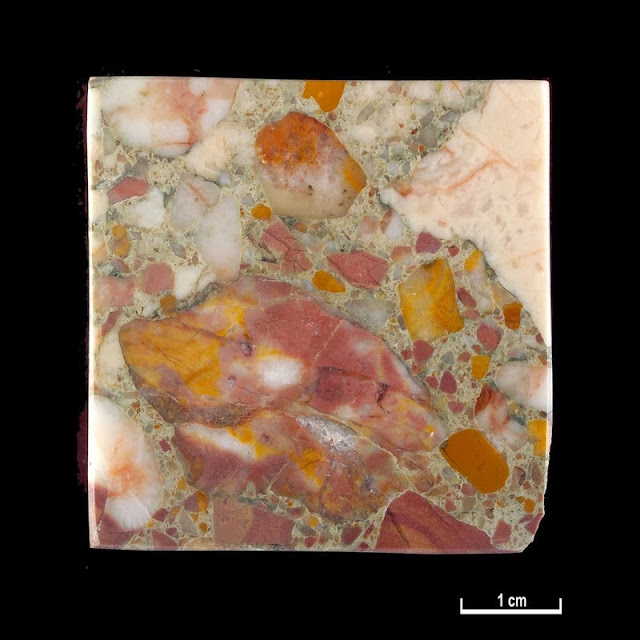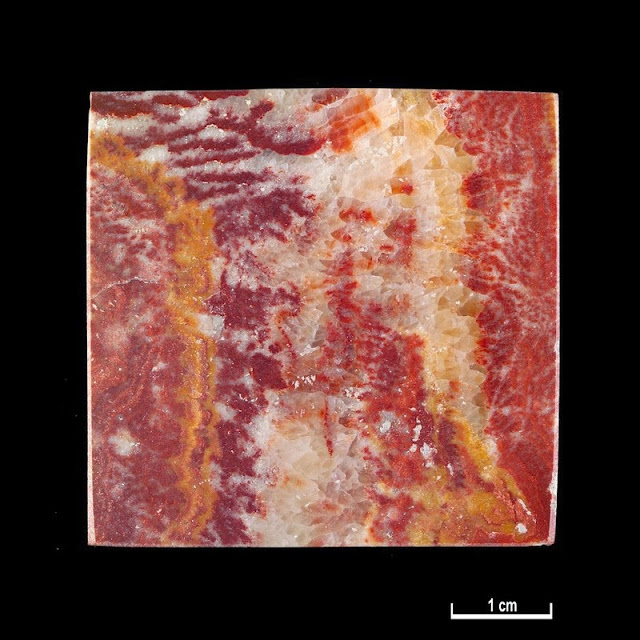 |
| BGS Image ID: P576068 |
P576068
Marble specimen. Calabria, Italy. Pallizzi Quarries, Calabria, Italy.
Calabria, Italy. Alternative name: Agrillei. Specimen description: Red/brown, orange and white fragments-veins. Anselm Odling.
Text from: Watson, J. British and foreign marbles and other ornamental stones. Cambridge : University Press, 1916:
317 AGRILLEI. Pallizzi Quarries, Calabria. This specimen is an example of the dark variety of Calabresian Marble. It is composed of reddish brown and orange-coloured brecciated fragments, in a greyish brown matrix.
 |
| BGS Image ID: P576086 |
Marble specimen. Emperor Red, Portugal. Pedra Furada Quarries, Pero Pinheiro, Estremadura.
Emperor Red, Portugal. Alternative name: Encarnado. Specimen description: Red with pink/white markings and small fossil fragments.
Text from: Watson, J. British and foreign marbles and other ornamental stones. Cambridge : University Press, 1916:
388 ENCARNADO (Emperor's Red). Pedra Furada Quarries, Pero Pinheiro, Estremadura. This is a red marble varied with streaks of dale pink and white, and faint outlines of small fossils may also be seen. In the British Isles this variety of Portuguese Marble is known commercially as Emperor's Red. It is not only in constant demand in Lisbon and other cities of Portugal for decorative purposes, but it is freely exported to England and other countries for similar work. Good examples of its use may be seen in St Roque's Church, Lisbon, and in the Municipal Hall, the internal decorations of both buildings being largely composed of it.
Emperor's Red is frequently used for ecclesiastical work in England. It appears in the Opus Alexandrinum pavement in the chancel of Bristol Cathedral (1895), and there are other examples in the chancel pavement of Truro Cathedral (1886), and in that of Peterborough (1895). It may be seen in many of the public buildings and hotels in London; for instance, in the Norfolk Hotel, and in the Drapers' Hall, built in 1898, where the handrails of the staircase and some of the door casings are composed of it.
It may interest the Cambridge student to hear that it was intended by Sir Gilbert Scott, the architect of St John's College Chapel, that the Communion-table slab in the chapel should be composed of Portuguese Emperor's Red Marble. It is stated that Sir Gilbert arranged with a marble merchant for the supply, but it was found afterwards that a block of Belgian Rouge Royal Marble (see No. 158 Watson J. British and foreign marbles. 1916.) had been furnished instead.
 |
| BGS Image ID: P576016 |
Marble specimen. Yellow Brocatelle, Spain. Tortosa Quarries, Prov. Tarragona, Spain.
Label name: Yellow Brocatelle, Spain. Alternative name: Tortosa Brocatello. Specimen description: Deep Red; containing yellow, white and transparent fossil fragments. Also known as / Brocatelle d'Espagne.
Text from: Watson, J. British and foreign marbles and other ornamental stones. Cambridge : University Press, 1916:
421 TORTOSA BROCATELLO. Tortosa Quarries, Prov. Tarragona. This large slab is a typical example of a class of marbles known in Spain as Brocatello, a term applied with slightly different meanings in Spain, France, and Italy. Spanish Brocatello, known usually as Tortosa Brocatello, and sometimes distinguished as Brocatelle d'Espagne, resembles a mottled marble in general appearance, but on closer inspection, it is found to be made up of a red ground, in which there are a multitude of fossils. Many of the shells are crushed, and are so closely packed as to form the body of the marble, a characteristic which causes it to be included in the group of marbles known as Lumachella, a name given to an ancient marble sometimes found in excavations at Rome, chiefly made up of small shells. The groundmass is deep red, but as the numerous fossils vary in colour from yellow to snow white, and are sometimes replaced by colourless transparent calcite, the marble, generally, has a light appearance.
The quarries are situated near Tortosa, a town in the Province of Tarragona. They were worked vigorously in ancient times, and the marble was then known as Marmor Schiston. During the Roman occupation large quantities were sent to Rome. It may be seen in the Church of St Maria Maggiore in that city, there being an example at the side entrance of the chapel. The high altar of St Cecilia is also partly composed of it. The altar of the Transept Chapel of the Church of St Paolo fuori le Mura has colonnettes of Tortosa Brocatello. There are numerous examples of its use in Naples, where columns of it may be seen in the Chapel of St Januarius. It is now chiefly used in Spain for small panels, mantelpieces, and clock cases, for which purposes it is also employed in England. It is, however, sometimes used in this country for ecclesiastical decorative work, together with other marbles. Instances of its use to form a mosaic pavement may be seen in the chancel of Bristol Cathedral (1895), and in those of Truro (1886) and Peterborough (1892).
 |
| BGS Image ID: P576026 |
Marble specimen. Red Onyx. Ain Smara Quarries, Algeria.
Red Onyx. Alternative name: Rouge Agate. Specimen description: Crimson with white, pink, purple and orange veins and mottled markings. M Marius Cantini, Marseilles.
Text from: Watson, J. British and foreign marbles and other ornamental stones. Cambridge : University Press, 1916:
694 ROUGE AGATE. Ain Smara Quarries, Constantine. This example represents a much more brilliantly coloured variety of Constantine Onyx Marble than those already described. As the specimen shews, a rich crimson colour dominates, besides which, white, pink, amber, and purple are present in the form of mottled markings and ribboned veins, so that the rock resembles polished agate.
The Walter Brown Collection of marbles is held at the Scottish Mineral and Lapidary Club. They were photographed at the British Geological Survey.
Posted by Bob McIntosh
No comments:
Post a Comment